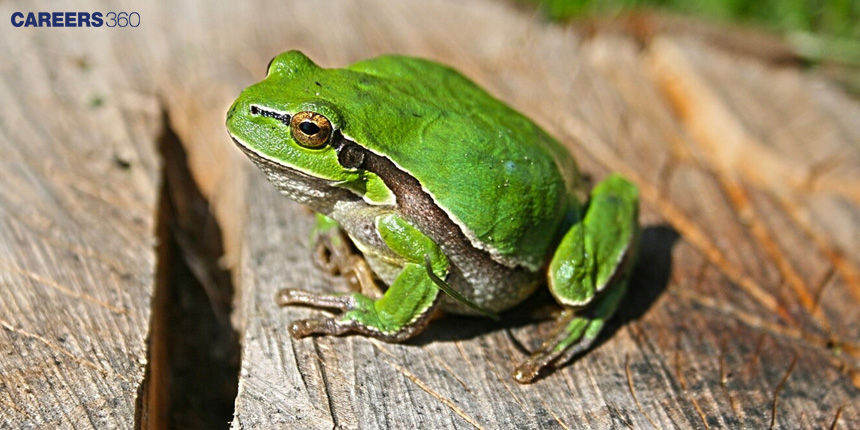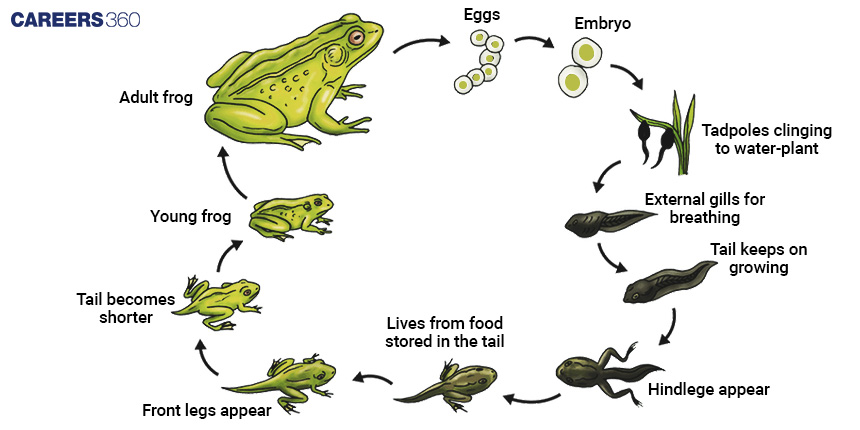Amphibia - Overview, Classifications, Defination
Amphibians are one of the important parts of the Animal Kingdom. They have their characteristics which help them to survive both on land and water. Amphibians include over 8,400 species worldwide, with 41 % threatened due to habitat loss, pollution, and disease. The topic Amphibia is from the chapter Animal Kingdom in Biology. This article includes characteristics of Amphibia, class, features, examples and diagrams.
NEET 2025: Mock Test Series | Syllabus | High Scoring Topics | PYQs
NEET Important PYQ's Subject wise: Physics | Chemistry | Biology
New: Meet Careers360 B.Tech/NEET Experts in your City | Book your Seat now
- What are Amphibians?
- Classification of Amphibia
- Characteristics of Amphibians
- Amphibians Examples
- Life Cycle of Amphibians
- Adaptations and Physiology of Amphibians
- Ecology and Habitat of Amphibians
- Recommended Video on Amphibians

What are Amphibians?
Amphibia are vertebrate animals characterised by living partly on land and partly in water in the different stages of their life cycles. They undergo metamorphosis from aquatic larvae to terrestrial adult stages. They form important links in ecosystems as both predators and prey, contribute to biodiversity by inhabiting wide and varied environments, and become indicators of environmental quality because of their sensitivity to habitat alteration.
Classification of Amphibia
The Orders of Amphibia are:
Anura (Frogs and Toads)
Anurans differ from others by their long hindlimbs, modified for jumping, and have no tail in the adult stage. They have a wide mouth and prominent eyes.
Frogs and toads occupy a wide variety of ecosystems, from rainforests and wetlands to arid deserts and mountainous locales.
They mostly breed in water, laying eggs that hatch into tadpoles, which go through metamorphosis into adult frogs or toads.
Anurans are major predators of insects and other small invertebrates, while they become the prey of many larger animals.
Caudata (Salamanders and Newts)
The Caudates are elongated, with a tail and often retain a lizard-like appearance of the body. They possess limbs of equal size and a distinct head.
They inhabit humid environments, forests, swamps, and streams. They are mainly distributed in the Northern Hemisphere.
Most salamanders lay eggs in water whose larvae are similar to adults but with external gills, some species have a direct development where the young hatch as miniature adults.
Salamanders and newts include predation and nutrient cycling during their life cycles.
Gymnophiona (Caecilians)
Caecilians are limbless, elongate amphibians that are somewhat earthworm or snake-like in appearance.
Their bodies are segmented in appearance and often have very small eyes, reduced sometimes to being covered entirely with skin.
They occur mainly in the tropics, in damp earthy or aquatic environments. Therefore, due to their underground nature, their lives are less spectacularly visible and less studied.
Some caecilians are egg-laying while others are viviparous. Most have parental care in which the mother's skin produces secretions utilized as food for young, some have even brood layers of skin.
Caecilians, being burrowers, aerate soils and help in regulating the number of invertebrates dwelling in soils.
Their activities played a very significant role in the maintenance of soil health and the dynamics of ecosystems.
Also Read:
Characteristics of Amphibians
Some general characteristics of Amphibians are:
Amphibians have smooth and moist skins with mucous glands to aid in respiration and water absorption.
Most amphibians possess four modified limbs, which are meant to undertake the more specialised modes of locomotion, for instance, swimming in water types and fast hopping on the ground.
They have digestive organs like the mouth, oesophagus, stomach, and intestines, which are modified with a view to carnivorous and herbivorous diets.
They manifest cutaneous respiration through the skin and display lungs or gills depending on the phase of life and habitat.
It contains a double-loop blood circulation with a three-chambered heart, where oxygenated and deoxygenated blood is pumped efficiently.
The nervous system consists of a brain and spinal cord, controlling sensory perception and motor functions.
Amphibians Examples
Examples of amphibians include:
- Frogs
- Toads
- Salamanders
- Newts
- Caecilians
Life Cycle of Amphibians
Most amphibians lay eggs in aquatic environments and then fertilise them outside their bodies.
Amphibians undergo metamorphosis from aquatic larvae, which are tadpoles with gills, into terrestrial adults with lungs.
The life stages of amphibians are embryonic, larval, metamorph, and adult all morphologically adapted to the environment and needs in those stages.
Diagram of Amphibian (frog) life cycle
The diagram given below shows the life cycle of an amphibian mainly frog with different life stages.

Adaptations and Physiology of Amphibians
The adaptions in the amphibians are described below:
Ecological Adaptations
Cutaneous respiration plays the role of gas exchange through the skin of amphibians, which is quite important to species without lungs or that are aquatic in stage.
As ectotherms, they cannot maintain their body temperature but depend on independent environmental conditions.
The animal shows great tolerance to changes in the environment.
Physiological Adaptations
They have evolved adaptive mechanisms in their skin anatomy to maintain the ever-changing body's water balance and osmoregulation.
With behavioural adaptations such as hibernation and aestivation, they pass through hostile periods and thus ensure perpetual survival in their wide range of habitats.
Ecology and Habitat of Amphibians
They range in habitats from terrestrial to aquatic and even semi-aquatic, making a home in forests, deserts, and less hostile freshwater bodies.
They are important in ecosystems in terms of predator-prey dynamics—amphibians are in turn predators of insects and other small vertebrates and become the prey of larger animals.
This demonstrates a significant role in nutrient cycling and energy transfer in food webs.
Importance to Humans
Amphibians are important for biomedical research due to their physiological similarities to humans.
Among the most important threats to amphibian populations are habitat loss, pollution, climate change, and diseases.
Conservation of such key species seeks habitat preservation with ex-situ captive breeding programs and disease management.
Also Read
Recommended Video on Amphibians
Frequently Asked Questions (FAQs)
Reptiles are generally known as creeping and crawling animals. They possess dry skin due to the presence of scales while the body of amphibians is usually soft due to absence of scales and possess glands to make skin moist.
There is no main difference between the heart of reptiles and heart of amphibians as both of them possess three chambered hearts that are two auricles and one ventricle . Crocodile is the only exception in The Reptile Kingdom which possesses an incomplete four chambered heart and poses double circulation.
Amphibians are called cold blooded animals because they match their internal temperature with the temperature of the surroundings . Reptiles are also cold-blooded animals. They maintain their body temperature so as to prevent them from the harmful effects of the environment.
Amphi means dual life as they possess the Dual mode of life which means they can live in the terrestrial environment as well as the Aquatic environment so these are called as amphibians.
In salamanders the fertilization occurs inside the body so they are termed as the internal fertilization amphibians.
Metamorphosis in amphibians consists of a transformation from the aquatic, larval stage with gills through terrestrial adults with lungs and the associated physiological and morphological changes.
Metamorphosis in amphibians consists of a transformation from the aquatic, larval stage with gills through terrestrial adults with lungs and the associated physiological and morphological changes.
Amphibians, to a greater extent, form habitats in both terrestrial and aquatic habitats, with some being exclusively aquatic or terrestrial. They are mostly associated with freshwater bodies such as ponds, streams, and wetlands, though some of them are resident in forests and even in arid deserts.
Amphibians, to a greater extent, form habitats in both terrestrial and aquatic habitats, with some being exclusively aquatic or terrestrial. They are mostly associated with freshwater bodies such as ponds, streams, and wetlands, though some of them are resident in forests and even in arid deserts.
The two critical roles that amphibians play, as both predators and prey, fall into their ecosystems in controlling insect populations and acting as food for larger animals. They also become engaged in nutrient cycling and energy flow, thereby ensuring the maintenance of ecological balance.
The two critical roles that amphibians play, as both predators and prey, fall into their ecosystems in controlling insect populations and acting as food for larger animals. They also become engaged in nutrient cycling and energy flow, thereby ensuring the maintenance of ecological balance.
Also Read
29 Nov'24 12:52 PM
26 Nov'24 04:23 PM
26 Nov'24 04:19 PM

